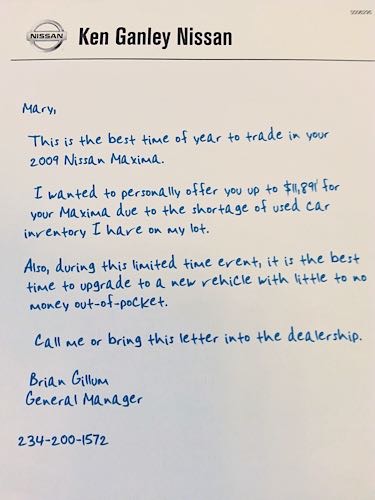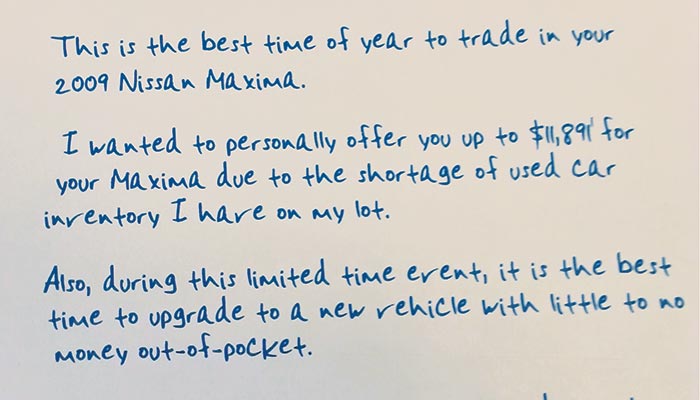 It seems that I get about two of these letters a week in the mail from local dealerships that are in hot pursuit of my seven-year-old Maxima. Signed by the general manager of the dealership, each letter claims a somewhat attractive offer for my vehicle, but with a disclaimer in fine print, of course. The letter goes on to say that during a limited-time sales opportunity, the dealership could offer me a great price on a new vehicle, if I were to upgrade my ride.
It seems that I get about two of these letters a week in the mail from local dealerships that are in hot pursuit of my seven-year-old Maxima. Signed by the general manager of the dealership, each letter claims a somewhat attractive offer for my vehicle, but with a disclaimer in fine print, of course. The letter goes on to say that during a limited-time sales opportunity, the dealership could offer me a great price on a new vehicle, if I were to upgrade my ride.
Dealers realize that if they can complement their new vehicle sales offerings with bringing more aftermarket-aged vehicles into their fold, they will have something to offer potential buyers of both new and used vehicles, keeping those customers within their grip.
Very solid evidence that the car dealers are after your service and repair dollars, wouldn’t you say?!
Why wouldn’t they be? Current market indicators spell nothing but opportunity on the aftermarket repair and service front.
 U.S. light vehicle sales are hovering at the 17.42 million-unit mark as of April. This represents the pipeline for vehicles to enter the aftermarket and a ton of service and repair opportunities that are ripe for the taking.
U.S. light vehicle sales are hovering at the 17.42 million-unit mark as of April. This represents the pipeline for vehicles to enter the aftermarket and a ton of service and repair opportunities that are ripe for the taking.
There are 272 million vehicles on U.S. roads today, driven by 214 million licensed drivers. More vehicles in operation (VIO) means there are more vehicles for you to service, especially as they reach the repair “sweet spot.”
The average vehicle age currently is at 11.6 years, and it will hover in that range for the next four years, with the sweet spot for repairs ranging from 6-12 years old. Older vehicles need more tender-loving care and repair.
With dealers wanting to eat your service dollars for lunch, now more than ever is the time to tout the benefits of proper vehicle repair, the value of routine maintenance in keeping your customers’ vehicles in top-running condition and the practicality of keeping their beloved aftermarket-aged vehicle for the long run. I know that’s what I’m going to do.














